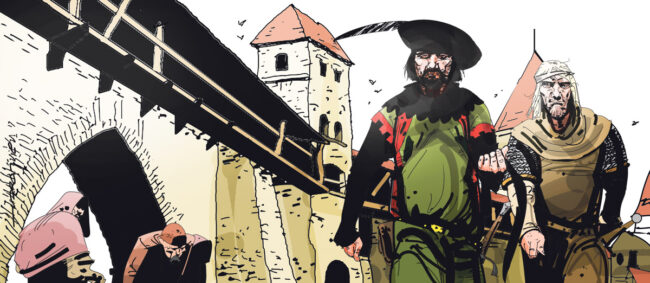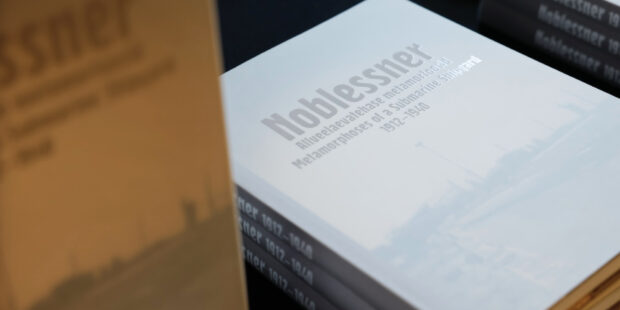The history of the beginning of Tallinn
Text Antti Sarasmo Pictures Illustration archive of The Baltic Guide/Hannu Lukkarinen
The area was like something from an adventure movie. A steep plateau with the sea almost at its foot. A little to the east of the upper plateau, a fast-flowing river flowed into the sea in a bay with a sandy beach.
The upper plateau, which was about seven hectares in size, was only accessible by a narrow ridge, used by people and wagons to transport goods. At the end of the ridge were massive gates to a fortress with wooden walls known as the Linda fortress, and that is almost all that is known about the Viking-era fortress.
According to one theory, it would have been a common security castle for the era. After all, there are many castle mounds in Finland and they were security castles. People went to castles for safety when attackers came. Military expeditions were usually mainly raiding expeditions and the raiding party did not start to surround the castle mound, because the booty was easier to get.
Estonian villages
There is no good arable land in the Tallinn area, there are a lot of swamps and areas of rocky ground, and no lush fields, such as those found on the banks of the Pirita River. This is where the first settlement of present-day Tallinn began. There was a small castle mound by the river and a small harbour at the river’s mouth.
The place was inhabited for a long time and the castle mound was conquered and destroyed several times. However, there was so much good arable land and fishing waters on the shores of Pirita that the village and castle hill were always rebuilt.
Life was the same as in nearby Finland, smokehouses, small barley fields, a few cattle, with hunting and fishing as side jobs for villagers.
There was a village a little further west, and there was already a feeling of a big world. The village of “Tallinn” was apparently located somewhere on the slope between where the Palace Hotel and the National Library exist today. Where exactly, it is not known, since the current buildings cannot be demolished to make way for archaeological excavations. However, a few finds suggest that there was a village in the area.
The location of the village was good. Next to it, the Härjapea River flowed down a steep slope towards Tallinn Bay. The mouth of the river was somewhere around where the Viru hotel is today. The land has risen and the river has brought sand, and man has filled in the shallow banks. However, in the 12th century, Tallinn’s coastline was far from what it is today.
Although the ships of the “Viru hotel harbour” were small. They were open and rowable “cargo ships” a bit like undersized Viking ships or overgrown archipelago boats. They did not need docks, but were pulled onto sandy beaches, such as the one at the “Viru hotel harbour”.
Trade was conducted and goods were transported. A safer route ran along the southern shore of the Gulf of Finland. There are only a few suitable harbours on the north coast of Estonia, because the shore is rocky, shallow and not protected from northern storms. The bay of Tallinn was exceptionally protected by islands, making it a good place to observe the weather, get clean drinking water and do a little shopping.
A good port gave birth to a port village. Merchant ships unloaded part of their cargo in the harbour and bought fresh food and repaired their ships in the village. The port village was not very large, because the terrain was not suitable for arable farming and everyone had to be, in modern terms, employed by the service sector.
The population of the port village of “Tallinn” was probably not enough to build and maintain the ancient castle on top of Toompea. The Linda fortress could certainly be seen in the village, but it is not known whether a local noble held his court there or whether it was a refugee castle.

The Danes are coming!
The king of Denmark decided to join the conquest of one of the last pagan corners of Europe, i.e. make a crusade. The Germans were already in Latvia, but Estonia was still without a ruler. In 1219, a large Danish fleet sailed into Tallinn Bay. The chronicles always exaggerate the number of warriors, but the Danes certainly had more than a thousand men in their army.
The military group camped somewhere near the park on the southern edge of present-day Freedom Square, and the gentiles who were part of the military group stayed on the sandy beach of the “Viru hotel harbour” to watch for ships.
At first, the Estonians of the neighbouring counties were moving in a constructive spirit. Both sides promised beautiful things. A couple of days later, however, the Estonians attacked the Danes’ camp. The fight was even until the Vends ran from the sandy beach to help. Their attack broke the battlefront of the Estonians. The Estonians retreated and the Danes won a significant victory.
In the Crusades, a great victory was always accompanied by a miracle. This time, a battle flag fell from the sky for the Danes, and when it flew over the army, the pagans were defeated. This “Flag of Denmark” is the Danneborg, the national flag of Denmark.
On the slopes of Toompea there is a place called the “Danish King’s Garden” where there is a statue commemorating the birth of the Danneborg. According to the latest research, the place is wrong and besides, the Danneborg did not make its first appearance on the slopes of Toompea, but was already one of the Danes’ battle flags. Anyway, the story is good.
The Battle of Linda Fortress was the birth of Tallinn. Denmark began to fortify Toompea. The wooden Linda fortress was dismantled and a stone castle was built on the site, which was occupied by a permanent garrison.
The Danish king divided Estonian villages into fiefdoms for his vassals. Usually, the vassal would rather live on the Toompea plateau than somewhere in his godless fiefdoms. The conquered region, i.e. Northern Estonia, also needed an administration, and of course, its centre was in the castle.
There had been a small village in Tallinn, but now more and more residents were coming all the time. Many things were needed, from shoeing horses to barrels, ropes and food. A concentration of craftsmen was born at the foot of the castle to serve the needs of the castle and the nobles living in Toompea.
Merchants were also needed, as taxes and the income of the nobility were paid in natural products such as grain. Someone had to exchange them for money or other products, and this required experts in foreign trade. The Danish king summoned 400 merchants from Gotland, more likely probably merchants and their families.
In this change, probably many assistant merchants from Gotland were able to rise to the position of independent merchants. The trading city of Tallinn was born.
The Danes came to establish a market town, although that was never the intention. Tallinn’s development was slow at first, because the Danish crown and the Order of the White Brothers fought for power in the city for almost the entire 13th century.
During the power struggle, neither side naturally invested much in the development of the city. Eventually, the Pope settled the dispute in favour of the Danish crown and the period of uncertainty ended.
A decent city wall was built at the beginning of the 14th century to replace the former stilt fences. Tallinn was the city of the Danes and its growth picked up speed.
To learn more about this and similar topicsBeginning of Tallinn Danneborg Denmark History of Tallinn Linda Fortress Pirita Tallinn Toompea










